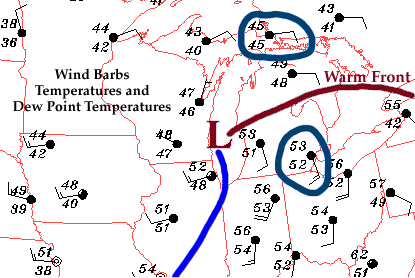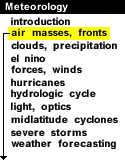
|
Another indication of a possible frontal passage is a change in the air's relative humidity. The air mass behind a warm front is typically more moist than the air mass ahead of the front. The surface map below contains reports of temperature, dew point temperature, and wind barbs. Higher dew points indicate a higher moisture content of the air. Ahead of the warm front analyzed below, dew point temperatures were generally in the 40's, while behind the front, dew point values climbed into the 50's.

This increase in dew point temperature indicated that the air behind the warm front contained more moisture. A noticeable change in the air's relative humidity is commonly observed with the passage of a warm front. Before the front arrives, the air typically feels less humid than after the warm front passes through.

wind shift |
|

cyclones |





